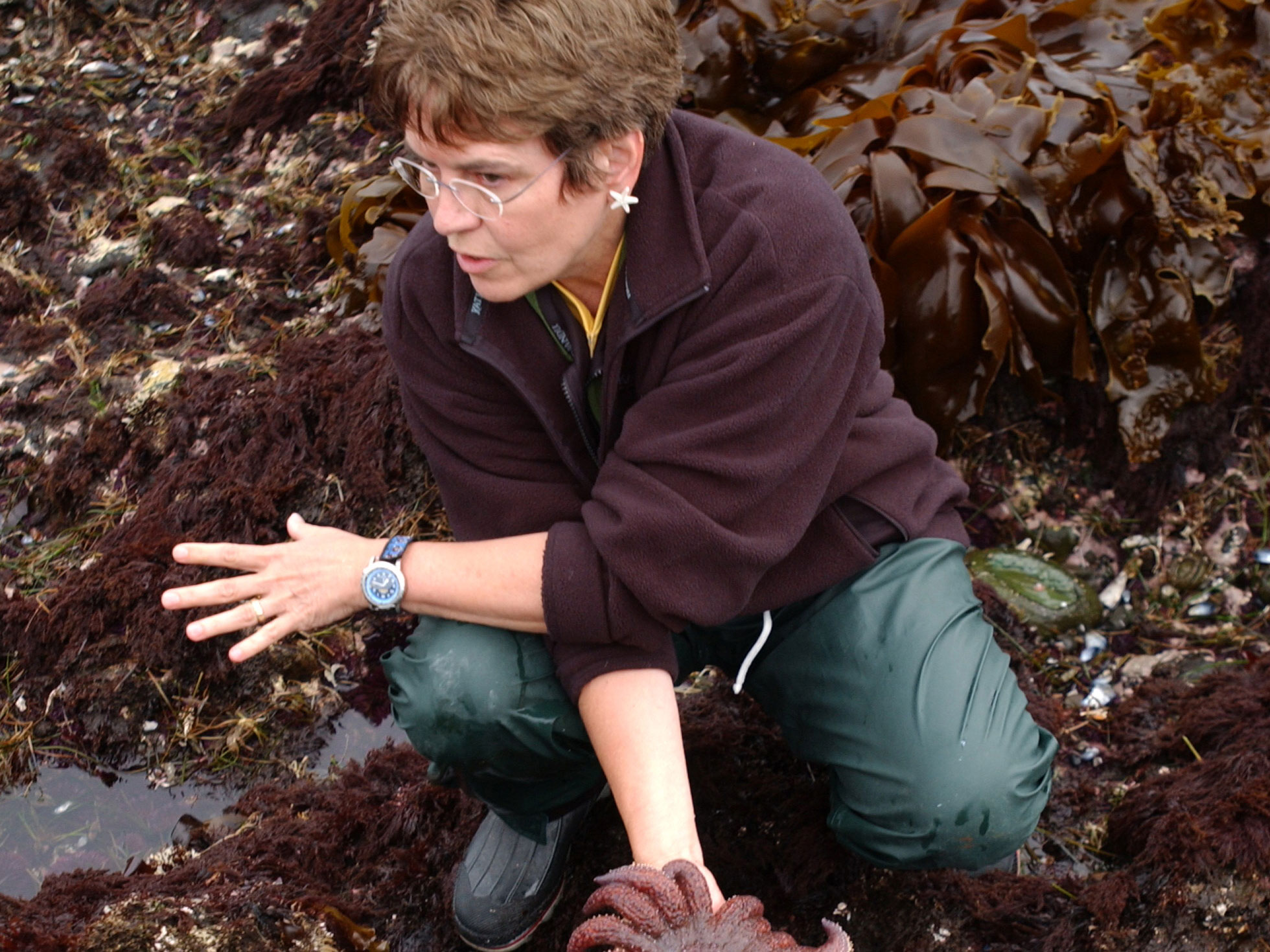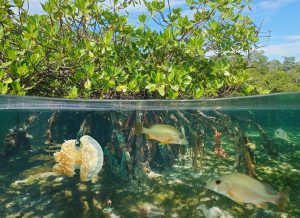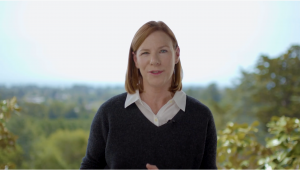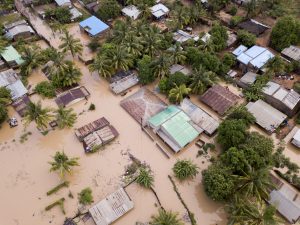We are thrilled to welcome Dr. Jane Lubchenco today to discuss the ocean-climate nexus. Dr. Lubchenco is a world-renowned environmental scientist who has deep experience in the worlds of science, academia, and government. From 2009 to 2013, she served as Administrator of NOAA and Under Secretary of Commerce for Oceans and Atmosphere. Nominated by President Obama in 2008 as part of his “Science Dream Team,” she is a marine ecologist and environmental scientist by training, with expertise in the ocean, climate change, and interactions between the environment and human well-being.
Listen to the interview
Interview Highlights
This is an edited version of the interview. You can download the full interview transcript here.
We were excited by the Science editorial that you recently co-authored with Steve Gaines. You call on scientists to switch gears from just documenting the challenge to contributing to solutions. Which solutions give you the most hope that we can drive transformative change for the ocean?
Thanks for the compliments on our Science editorial. It was great to have a chance to talk about how people think about and act with respect to the ocean is changing. The fact that the ocean sustains us, feeds us and connects us is a really important place to begin talking about the ocean. It is our past; but it’s also, I believe, our future. That’s why the focus should be on solutions and thinking about the ocean in the way that it integrates so many other important things. Many people think about the ocean as doom and gloom. We know that the ocean is higher, warmer, stormier, more acidic, and has less oxygen. And that means it’s also more disrupted and less predictable than it has been. Those are huge challenges.
The exciting thing to me is that people are beginning to pivot from seeing all the problems to focusing on, “Okay, what can we do about it?” and, importantly, “What are the co-benefits that might bring good outcomes to multiple things we care about?” What I see is that there is a huge amount of really exciting things bubbling up globally. They’re not at the scale that we need, they’re not in many cases very well known, but they are very encouraging and provide a very clear path forward to identify these solutions, to adopt them, to amplify, to scale them up in ways that are feasible and would bring multiple benefits.
What I see is that there is a huge amount of really exciting things bubbling up globally. They’re not at the scale that we need, they’re not in many cases very well known, but they are very encouraging and provide a very clear path forward.
One of the solutions that is tremendously exciting is that there’s a major shift underway in fisheries management. There is a new focus on ending overfishing and recovering depleted fisheries. This is not easy to do, but we’ve seen instances where it is possible and the result is far more fish in the ocean, a more vibrant fishing industry, more food security, and healthier ocean ecosystems. There is a triple bottom line win that is absolutely worth the difficulties in making this transition to sustainable fisheries.
When I was at NOAA, it was mandated by Congress to end overfishing and to do it within a certain timeframe. It was a very challenging, very painful thing to do. But the result has really been transformative for U.S. fisheries. We have turned things around in a way that is totally remarkable and is not well known.
In 2000, there were 92 stocks of federally-managed fisheries that were overfished. By 2018 there were 41. So, the number of overfished stocks has been slashed and that’s pretty impressive. Even more so, is the number of stocks that were significantly overfished so badly that the fishery was closed, and now the stock has been rebuilt to a healthy level where it can again be fished. In 2000, there were zero of those rebuilt stocks, but by 2018 there were 45 of them. And since 2008, these fisheries have resulted in a 21 percent increase in catch and a 24 percent increase in value as the stocks are rebuilt and as they can again be fished. So that’s just one example of many around the world where we have demonstrated that sustainable fisheries is not just a good idea, it’s actually feasible.
Another solution that I find very exciting is around illegal fishing, or, “IUU fishing” (Illegal, Unregulated, and Unreported fishing), and it has been a huge problem for decades. The best estimates are that it represents about $23 billion dollars annually and as much as one in five wild capture fish are caught illegally. It’s a big problem, and threatens legitimate fisheries, undermines governance, and is a huge detriment to the health of ecosystems because illegal fishing practices destroy habitat. It’s been a problem because the ocean is so huge and it’s hard to patrol every place. Fortunately, we have seen a number of things come together that are converging to tackle, in some very significant ways, what many thought was an intractable problem. We’re seeing new policies, new tools, new leadership, increased public awareness, all converging to combat IUU fishing.
Fortunately, we have seen a number of things come together that are converging to tackle [IUU fishing] in some very significant ways, what many thought was an intractable problem. We’re seeing new policies, new tools, new leadership, increased public awareness, all converging to combat IUU fishing.
A third solution that gives me hope are Marine Protected Areas (MPAs). These are areas of the ocean that are protected to one degree or another from extractive and destructive activities. A decade ago only about 0.3 percent of the ocean was in a Marine Protected Area. Fast forward to now, we have about 5 percent of the ocean in implemented marine protected areas and about 3 percent of that is in the strongest type of protection, “fully protected” or “highly protected” MPAs. Those MPAs are one of the strongest tools that we have to protect biodiversity and to enhance the resilience of ocean ecosystems. We also know that they can be very powerful tools in providing safe havens for wildlife, and also capturing and storing carbon, restoring ecological balance, protecting coastal areas from storm surge and coastal erosion, preserving genetic diversity, and helping recover depleted fisheries.

Photo: Oregon State University
Thank you so much for such concrete and evidence-based examples. As we approach global biodiversity targets to protect 10 percent of marine and coastal areas by 2020, what are your recommendations on how protection levels and definitional clarity should play into the post-2020 biodiversity agenda?
It’s useful to consider that for most of human history, most of the ocean was too far away from land, too inaccessible, too deep, for people to routinely exploit. It’s only been in the last few decades that technology has allowed us to routinely go there, and extract things from it. Today, we virtually fish, drill, and mine everywhere, so it’s not surprising that we are now having these conversations about “what have we lost and what do we need to restore?” We need a healthy, productive, and resilient ocean. Fully protected marine areas are the best tool to help achieve that.
MPAs are a really powerful tool but are seriously underutilized. We now have good science that documents their outcomes. It’s crystal clear that there are good outcomes that benefit people in the short term and in the long term. But it’s also important to recognize that there are thousands of types of MPAs. Everything from “you can’t take anything out and you can’t even go there”, to the other end of the spectrum which is: only a single species is protected but everything else can happen in that protected area. As countries have set targets and gone about creating protected areas, there is huge confusion about how much is protected, how much protection is needed and what is it going to do for us? To help alleviate confusion around types of MPAs, outcomes, and how much we have, a group of people has worked diligently to create the MPA Guide. The MPA Guide is a simple framework for helping people understand and use the same language, the same terms, so we’re all talking about the same things and we can communicate better.
Most of the studies that have been done by scientists about how much of the ocean needs to be protected have come up over and over again with at least 30 percent of the ocean should be in highly to fully protected MPAs. We need protection of each ecosystem with enough protection that it continues to be healthy, productive, and resilient so we have protected areas that are well managed, well financed, and well supported that are adjacent to sustainably used areas outside.
There are several important events this year that may help policymakers recognize climate-ocean linkages, from the IPCC’s “Special Report on the Ocean and Cryosphere in a Changing Climate” to the Conference of the Parties (COP25) which is being dubbed the “Blue COP.” Do you think there is an increasing appetite among policymakers to integrate the ocean into climate solutions?
It has been the case for a long time that the climate policy community just ignored the ocean. Fortunately, starting with the Global Climate Action Summit that was in September a year ago now, in San Francisco, that door was open, and in a way that surprised a lot of people. That conversation has only strengthened. Certainly, with the Blue COP in December but also Costa Rica with the Pre-COP in October are both saying strong things about including the ocean in this portfolio of tools that we have to both mitigate climate change, but also adapt to climate change. In my view, the ocean should absolutely be on climate policymakers’ radar screen both on the mitigation side and on the adaptation side. A number of countries are keenly interested in beginning to incorporate the ocean in their NDCs [Nationally Determined Contributions] under the Paris Agreement.
In my view, the ocean should absolutely be on climate policymakers’ radar screen both on the mitigation side and on the adaptation side. A number of countries are keenly interested in beginning to incorporate the ocean in their NDCs [Nationally Determined Contributions] under the Paris Agreement.
I think there is also an increased recognition that many of the opportunities for mitigation and adaptation also bring co-benefits. By decreasing carbon, you can increase the adaptation potential, you can increase food security, you can increase biodiversity protection through, for example, Marine Protected Areas. The High Level Panel for a Sustainable Ocean Economy, which is a group of 14 heads of state that have agreed to work collectively to focus on ways to protect, to produce, and to prosper (“Three P’s”), have honed in on this huge opportunity of this ocean-climate nexus and are releasing a report in September at the UN General Assembly with some new and very exciting climate analyses about opportunities for mitigation with respect to ocean activities.
The kinds of things that people are talking about for mitigation opportunities in the ocean space tend to revolve around ramping up renewable energy from the ocean, and that seems to be a huge opportunity that is still untapped. A second area is to recognize how important shipping is. There are huge opportunities to make shipping greener, to reduce carbon emissions from the whole transportation enterprise. There are other kinds of sub-sectors that are being actively discussed and analyzed. One of those are nature-based solutions focused on blue carbon and other kinds of things but looking at opportunities for ocean and coastal ecosystems to absorb and store carbon. We have learned how incredibly important some specific coastal ecosystems are in terms of their abilities to store and sequester carbon. In particular, mangroves, and seagrass beds, salt marshes, are really more “bang for the buck” in terms of carbon stored per unit area than any other habitat on Earth.
Beyond mitigation, there are huge important additional benefits in the adaptation space. There has been less attention to that, but I think we will be seeing more and more in the years to come. It couldn’t be coming at a more important time given how important it is to address climate change, but this increased focus on the ocean as central to our future really incorporates and brings together all of the different threads that are climate, food security, human well-being, economic opportunity, healthy opportunities to live and work and play. It’s exciting as an ecologist to see all of these different threads finally coming together because they’ve been too disparate for far too long.
Let’s wrap up thinking about effective science communications. You have called on scientists to not only discover knowledge but to share that knowledge more fully with society through engagement with the public, decision makers, media, and private sector. Can you share an insight or two about what you’ve learned through this work and how it might apply to professionals engaged in environmental communications today?
What I’m seeing is that young people today, young scientists and young scientists in training, really understand how important it is to connect science to society. The old concept of scientists in the ivory tower in academia making discoveries and eventually having that knowledge be published and eventually making it into policy and management just doesn’t work anymore. Things are happening too fast. The younger generation…they’re impatient and rightly so. They want to get on with the solutions, so I think we’re seeing a real revolution in the academic world, not just a focus on communication, but on more engagement with society.
Communication is talking about something and trading ideas in two ways, but engagement is really working together to understand a problem and craft a solution and implement it. We’re seeing more of a focus on co-creation of knowledge and engagement of scientists with society. I personally believe that one of the best anecdotes to the post-truth world that we are seeing is for more citizens to be part of this knowledge creation with scientists, not just the recipients of scientific knowledge, but participating in citizen science and actively understanding what the process is and contributing to it; and, therefore, having a lot more trust in science and more understanding of the scientific process.
I think there are some really exciting opportunities now for scientists, whether they’re in academia or elsewhere, to be tackling real-world problems, focused on solutions, but engaging with users in a way that is pretty radical for what scientists- or, what most scientists- have done historically. It couldn’t come at a better time; we need that now more than ever before, and the ocean space has proven to be really ripe for this engagement to scientists in solving global and local ocean problems. We really do have huge opportunities but also huge problems, so we need an all hands on deck approach. Science can help inform understanding and can help co-create solutions so we will be in a much better position to implement solutions much faster than we currently are at present. If we’re to achieve the vision of Our Shared Seas, we really need all hands on deck. That means engagement of not only scientists, but everyone who benefits from the ocean, which of course, is everyone, and everyone who contributes to changes in the ocean which is of course, again, everyone.
“There are some really exciting opportunities for scientists to be tackling real-world problems…It couldn’t come at a better time; we need that now more than ever before…”



